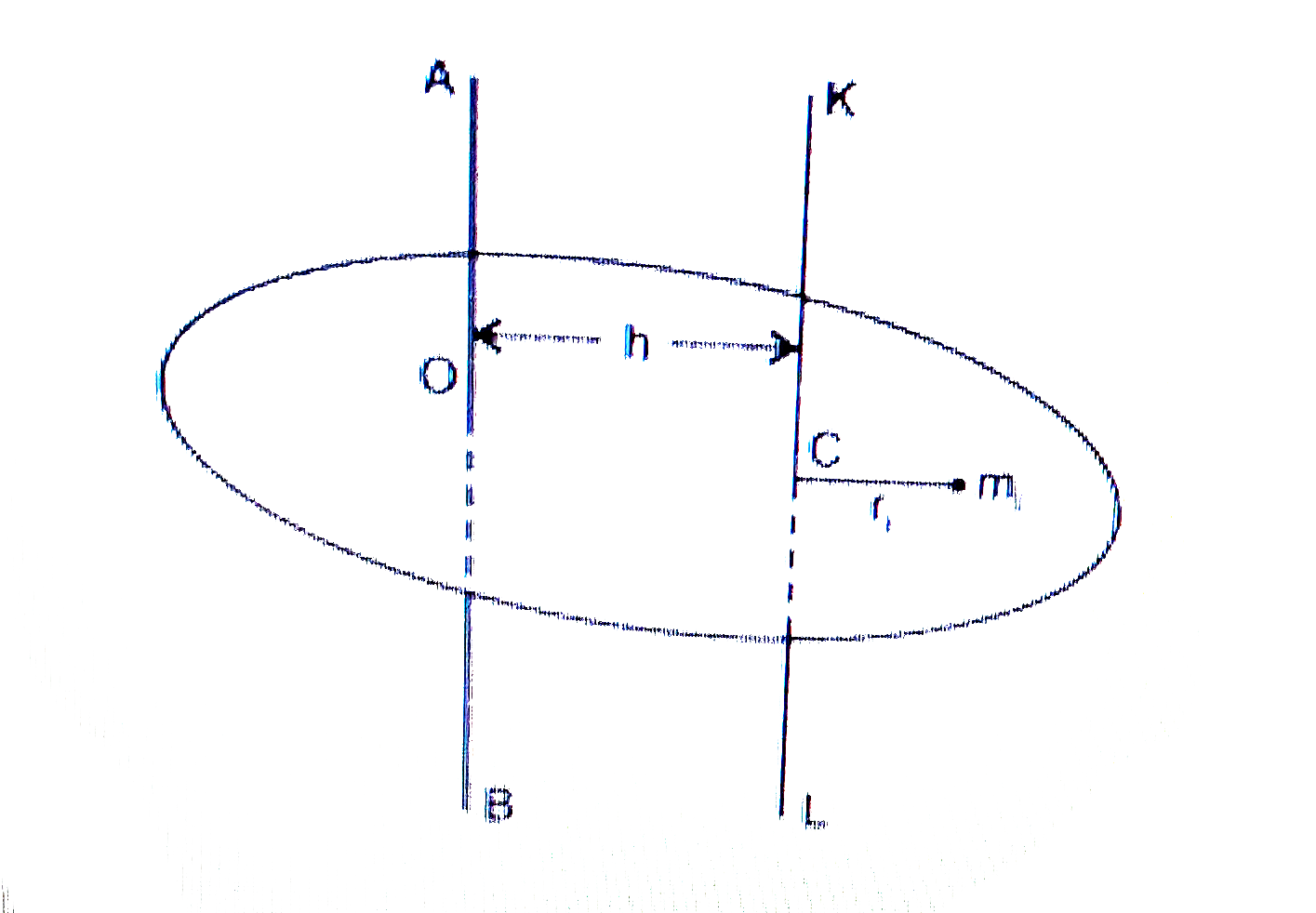(a) Prove the theorem of perpendicular axes.
(Hint : Square of the distance of a point (x, y) in the x-y plane from an axis through the origin and perpendicular to the plane is ^(x2)+y2).
(b) Prove the theorem of parallel axes.
(Hint : If the centre of mass of a system of n particles is chosen to be the origin ∑miri=0).
(a) The theorem of perpendicular axes : According to this theorem, the moment of inertia of a plane lamina (i.e., a two dimensional body of any shape/ size) about any axis OZ perpendicular to the plane of the lamina is equal to sum of the moments of inertia of the lamina about any two mutually perpendicular axes OX and OY in the plane of lamina, meeting at a point where the given axis OZ passes through the lamina. Suppose at the point R m {particle is situated moment of inertia about Z axis of lamina
=moment of inertia of body about r-axis
=moment of inertia of body about y-axis.

(b) Theorem of parallel axes : According to this theorem, moment of inertia of a rigid body about any axis AB is equal to moment of inertia of the body about another axis KL passing through centre of mass C of the body in a direction parallel to AB, plus the product of total mass M of the body and square of the perpendicular distance between the two parallel axes. If h is perpendicular distance between the axes AB and KL, then Suppose rigid body is made up of n particles m1, m2, __mn, mn at perpendicular distance r1,r2,r1rn respectively from the axis KL passing through centre of mass C of the body.
If h is the perpendicular distance of the particle of mass m from KL, then

The perpendicular distance of ith particle from the axis
AB=(ri+n)
or IAB=∑imi(ri+h)2
=∑imi(r2i+h2+2rih)
=∑imir2i+∑imih2+2h∑imiri
As the body is balanced about the centre of mass, the algebraic sum of the moments of the weights of all particles about an axis passing through C must be zero.
∑i(mig)ri=0 or g∑imiri
or ∑imiri=0
From equation (ii), we have
IAB=∑imir2i+(∑mi)h2+0
or IAB=IKL+Mh2
where IKL=∑imir2i and M=∑mi

Topper's Solved these Questions
- BOOK - NCERTCHAPTER - SYSTEMS OF PARTICLES AND ROTATIONAL MOTIONEXERCISE - EXERCISE33videos
SYSTEMS OF PARTICLES AND ROTATIONAL MOTION
- BOOK - NCERTCHAPTER - PHYSICAL WORLD EXERCISE - EXERCISE16videos
PHYSICAL WORLD
- BOOK - NCERTCHAPTER - THERMAL PROPERTIES OF MATTEREXERCISE - EXERCISE22videos
THERMAL PROPERTIES OF MATTER
Similar Questions
The distance of the point (1,−2,4) from the plane passing through the point (1,2,2) perpendicular to the planes x−y+2z=3 and 2x−2y+z+12=0 is
View SolutionIf plane passes through the point (1, 1,1) and is perpendicular to the line,x−13=y−10=z−14, then its perpendicular distance from the origin is
View Solution
Knowledge Check
- Question 1 - Select One
By the theorem of perpendicular axes, if a body be in X-Z-plane then :-
AIX−IY=IZBIZ+IY=IXCIZ+Ix=IYDIy+IZ=IX - Question 2 - Select One
The equation of a plane passing through origin and perpendicular to the line x=2y=3z is
Ax+2y+3z=0B3x+2y+z=0C6x+3y+2z=0D6x-3y+2z=0 - Question 3 - Select One
Equation of the passing through the origin and perpendicular to the planes x+2y+z=1, 3x−4y+z=5 is
Ax+2y−5z=0Bx−2y−3z=0Cx−2y+5z=0D3x+y−5z=0
Find the equation of the plane passing through the points (1,0,-2),(3,-1,0) and perpendicular to the plane 2x-y+z=8.Also find the distance of the plane thus obtained from the origin.
View SolutionThe perpendicular distance from origin to the plane 3x−2y−2z=2 is :
View SolutionThe point of intersection of the plane 3x−5y+2z=6 with the straight line passing through the origin and perpendicular to the plane 2x−y−z=4 is
View SolutionIf the point of intersection of the plane 4x−5y+2z−6=0 with the line through the origin and perpendicular to the plane x−2y−4z=4 is P, then the distance of the point P from (1, 2,3) is
View SolutionLet the plane passing through the point (−1,0,−2) and perpendicular to each of the planes 2x+y−z=2andx−y−z=3 be ax+by+cz+8=0. Then the value of a+b+c is equal to
View Solution

